BMI in Excel, or Body Mass Index, is a crucial health indicator that assesses an individual’s weight relative to their height. Calculating BMI in Excel provides a convenient and accurate way to monitor one’s health. In this guide, we will explore how to use Excel to calculate BMI effortlessly, making it a valuable tool for individuals, healthcare professionals, and fitness enthusiasts alike. Whether you’re striving for a healthier lifestyle or conducting medical assessments, mastering BMI calculations in Excel empowers you to make informed decisions about your well-being and those you care for.
These content covers:
- What is BMI?
- How to use BMI calculation formula in Excel?
- Calculate BMI in Excel
- Applying IF Function to Calculate BMI in Excel
- How to use Body Mass Index – BMI – Excel formula?
- How to use BMI in Excel for Feet and Pounds?
1. What is BMI?
Adults can be categorized as underweight, overweight, or obese using the Body Mass Index, a straightforward weight and height index. Age does not affect BMI levels, which are the same for both sexes.
2. How to use BMI calculation formula in Excel?
For calculating the BMI in Excel you can follow the below steps.
Step 1: Create a data table with the information below.
Placed the information here.
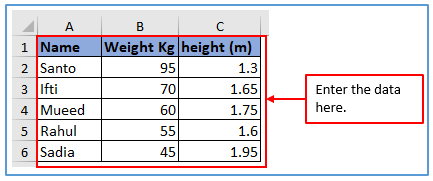
Step 2: Add a column D1:D6 to get the BMI of every person and named it BMI.
Added a column here.
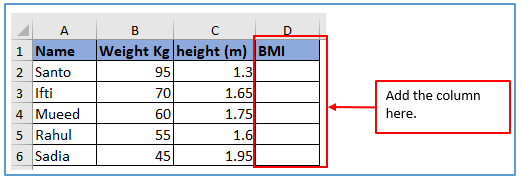
Step 3: Now, use the formula according to the information and column to get the BMI result. Formula: = weight/height^2 or =B2/C2^2.
The formula is used here.
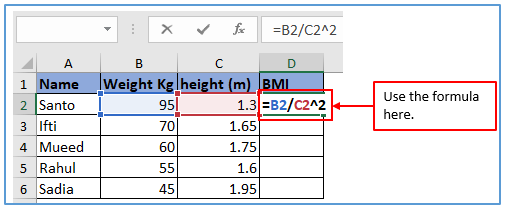
Step 4: press the enter button and get the BIM result.
The result is shown.

Step 5: Like the way above, use the same formula with changing column number or drag- down the cursor from the first BMI result and you will get the BMI result for all.
The result is outlined below:
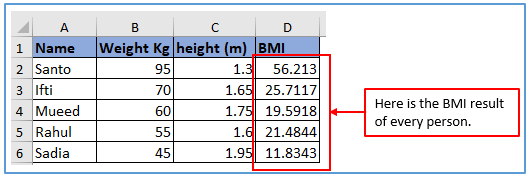
3. Calculate BMI in Excel
-
- Applying IF Function to Calculate BMI in Excel:
For calculating Body Status, if a person is normal, overweight, or obese, we will show the result by using the IF function in Excel.
Step 1: Create a data table with the information below.
Placed the information here.
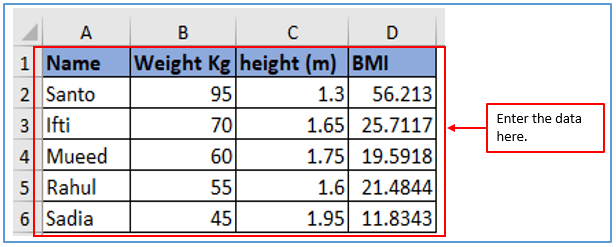
Step 2: Add a column E1:E6 to get the BMI of every person and named it Status.
Added a column here.

Step 3: Now, use the formula according to the information and column to get the Status of BMI. Formula: =IF(D2<=22,”underweight”,IF(D2<=25,”normal”,IF(D2<=57,”overweight”))).
The formula is used here.

Step 4: Press the enter button E3 to represent the status of the person.
The result shows that Shanto’s BMI status is Overweight.

Step 5: Like the way above, use the same formula with changing column number or drag- down the cursor from the first status result and you will get the Status of BMI result for all.
The result is outlined below:

4. How to use the Body Mass Index – BMI – Excel formula?
Step 1: Create a data table.
Placed the information here.

Step 2: Add a column D1:D2 to get the BMI of Risad.
Added a column here.

Step 3: The BMI formula for metric measures is: weight (kg) / height (m)2. Weight in Kilos divided by the square of height in meters. The ^ means ‘raise to the power’. Now, use the formula according to the information and column to get the BMI result. Formula: = weight/height^2 or =B2/C2^2.
The formula is used here.

Step 4: Press the enter button.
The result is shown below.

5. How to use BMI in Excel for Feet and Pounds?
Step 1: Create a data table with the information below.
Placed the information here.

Step 2: Add a column in C1:C2 and D1:D2 to get the BMI for feet and pound.
Added a column here.

Step 3: A single formula for using feet with inches /pounds in a BMI calculation looks like this: A2 is weight in pounds.
Here is the formula for weight in pounds: =CONVERT(D7,”lbm”,”kg”)

Step 4: Here is the result of the converted weight in pounds.
Here is the result.
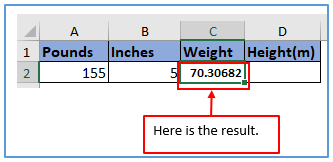
Step 5: B2 is the height part in feet.
Here is the formula for height in feet: =CONVERT(B2,”ft”,”m”)^2

Step 6: Press the enter to get the number.
Here is the result of height in feet.

You may be interested:
